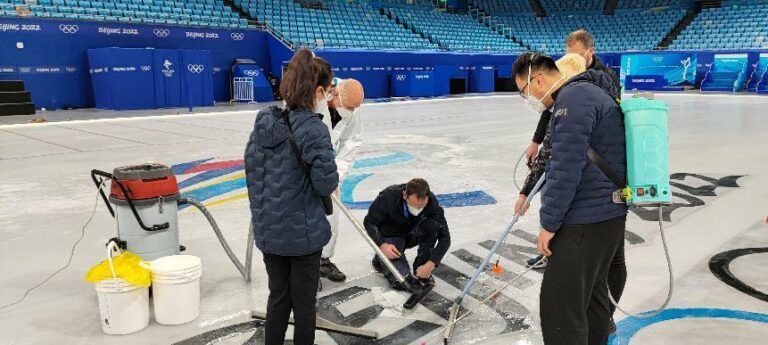
By Chen Shangwen, People’s Daily
Remy Boehler, a French ice expert, together with his Chinese colleagues, has endeavored to create ideal ice surfaces in the Capital Indoor Stadium in Beijing that can both satisfy the needs of short track speed skaters and figure skaters from various parts of the world, as figure skating and short track speed skating competitions of the Beijing 2022 Winter Olympics have been arranged to be staged on the same rink in the venue.
In 1992, Boehler, who was 16, received his first Olympics assignment: driving ice resurfacing for the 1992 Winter Olympics in Albertville, which was also the first time that he had engaged in ice-making work, Boehler told People’s Daily during an interview.
Since then, Boehler has served many major winter sports events, including Winter Olympics and world championship, accumulating rich experience in ice-making, according to the expert.
After finishing ice-making work for figure skating and short track speed skating competitions at the 2018 PyeongChang Winter Olympic Games, Boehler was invited by the Beijing Organizing Committee for the 2022 Olympic and Paralympic Winter Games (BOCOG) for the ice-making work at the Capital Indoor Stadium, and then quickly joined the preparations for the Games.
For the goal of delivering a splendid Winter Olympics, Boehler has cooperated closely with the Chinese team for nearly four years.
The biggest challenge in the ice-making work at the Capital Indoor Stadium is that figure skaters and short-track speed skaters need different ice surfaces, according to Boehler, who added that the ice-making team needed to carry out a meticulous study to create perfect ice surfaces for both events.
While figure skaters prefer softer ice surfaces which enables them to better perform jumps, short-track speed skaters favor harder ice surfaces because it allows them to skate fast, Boehler explained.
If short-track speed skaters can glide very fast and figure skaters can jump high in competitions, then the ice-making work of the team is successful, Boehler said.
To make sure the temperature of the ice surface is within the optimum ranges required by figure skating and fast track speed skating competitions every day, the team adjusts the condition of the ice surface and changes protective pads several times a day, and the ice master works closely with Chinese engineers in charge of machinery and equipment to keep close control over the temperatures of the air, water, and the refrigerating system of the rink, according to Boehler.
Completed in 1968, the Capital Indoor Stadium is the first modern stadium built in China after the founding of the People’s Republic of China and has China’s first artificial indoor ice rink. “It feels amazing to watch the place change every day,” said Boehler.
His cooperation with the ice-making team of the venue is a very exciting and enjoyable experience, the ice master said. Every member of the team works in unison and always solves problems actively, which is precious, according to Boehler.
“As a matter of fact, every colleague has shown great enthusiasm for ice-making work,” he said, noting that it was exactly their passion for ice sports that brought these team members together.
The experience of working at the Capital Indoor Stadium makes him confident about the ice rink of the venue and the success of the Beijing 2022, Boehler said.
On Feb. 4, the venue hosted the first figure skating competition of the 2022 Olympic Winter Games. On the next day, China won the first-ever Olympic short track speed skating mixed team relay gold medal at the Capital Indoor Stadium, which was also the first gold medal claimed at the venue during Beijing 2022.
“It’s beyond all doubt that the world will see spectacular competitions on this ice rink,” Boehler said.










